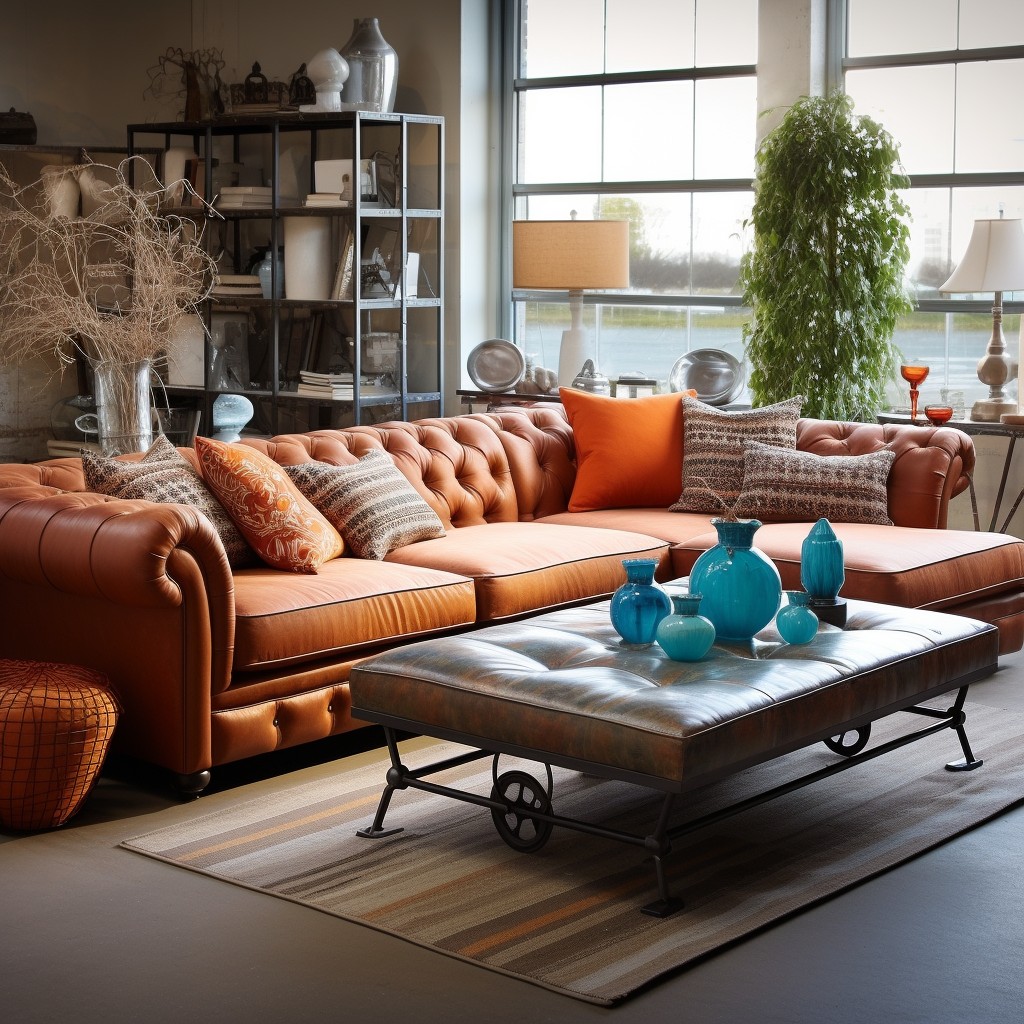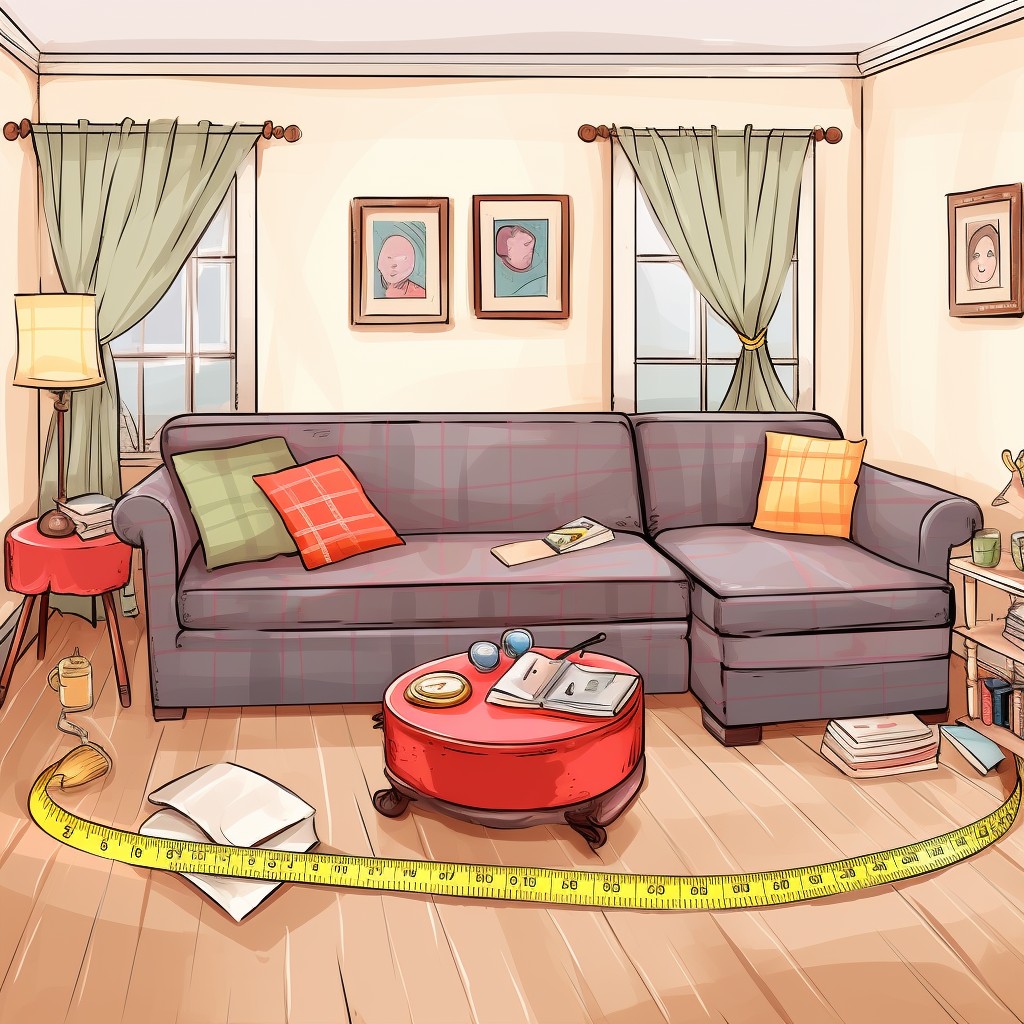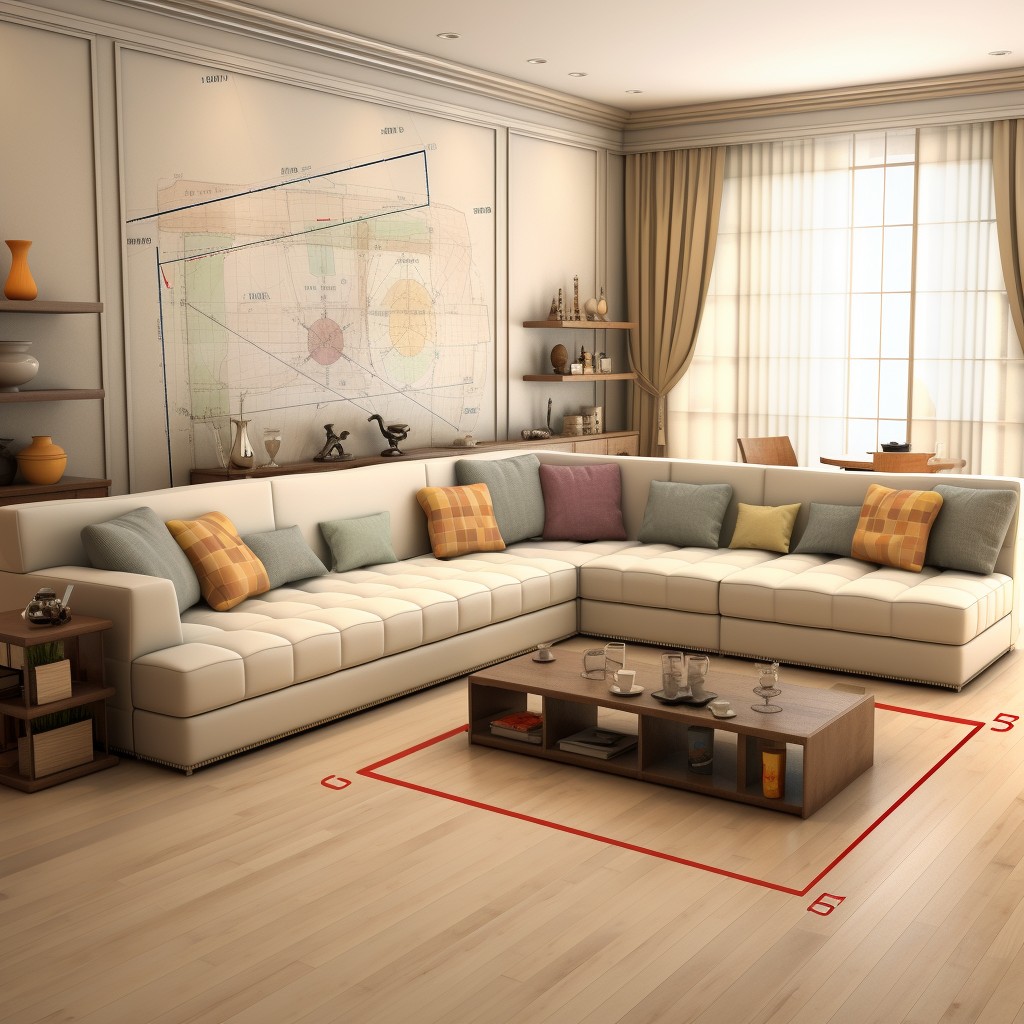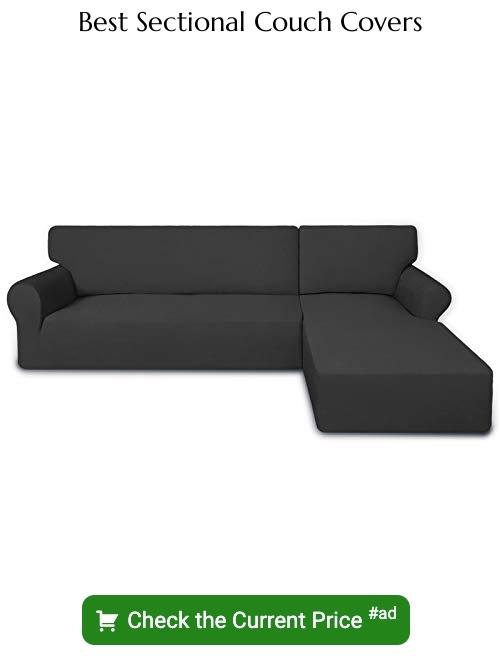Last updated on
Discover the simple steps to accurately measure your sectional couch, ensuring a perfect fit for your living space and maximizing comfort.
Are you planning to buy a sectional couch but don’t know how to measure it? Worry not, because in this article, we will guide you on how to measure a sectional couch like a pro. Measuring your furniture is crucial before making a purchase because it ensures that the piece fits perfectly in your space.
It also saves you from the hassle of returning or exchanging the item if it does not fit. So, whether you’re moving into a new home or simply upgrading your living room, read on and learn how to measure a sectional couch with ease.
Table of Contents
Types of Sectional Couches

The most common sectional sofa designs include L-shaped, U-shaped, curved or rounded sectionals. L-shaped sectionals are perfect for small living rooms as they fit snugly into corners while providing ample seating space.
U-Shaped sectionals offer more seating capacity than their L-Shaped counterparts and are ideal for larger living spaces.
Curved or rounded sectional sofas add a touch of elegance to any room with their unique design that curves around the walls of your home. They work well in large open spaces where you want to create a cozy conversation area.
Necessary Measuring Tools

You don’t need anything fancy or expensive; just a few basic items will do the trick. Here are some necessary measuring tools that you should have:
1. Tape Measure: A tape measure is an indispensable tool for any home improvement project, including measuring furniture dimensions.
2. Pen and Paper: It’s always helpful to write down measurements as you take them so that you can refer back to them later.
3. Level: A level helps ensure accuracy when taking measurements of height and length.
4. Angle Finder (Optional): An angle finder is useful if your sectional has angled corners or curves that require precise measurement.
Before You Start: Understand the Key Sectional Sofa Dimensions

This knowledge will help you take accurate measurements and ensure that the furniture fits perfectly in your living space.
The three main dimensions of a sectional couch are length, width, and height. The length refers to how long the sofa is from one end to another.
Width measures how wide each section of the sofa is from side-to-side while height measures its vertical distance from floor level.
Another important dimension when measuring a sectional couch is diagonal depth or corner depth. It refers to how deep each corner section goes into space diagonally across both sides of the piece.
Understanding these key dimensions will help you measure your furniture accurately and choose an appropriately sized piece for your home’s layout and style preferences.
Measuring Length of Sectional Couch

It determines how much space it will take up in your room and whether it fits comfortably with other pieces. To measure the length, you need to start from one end of the sofa and measure all the way to another end, including any arms or extensions.
To get an accurate measurement, use a tape measure that can extend at least 10 feet long. Begin measuring from either side of your sectional couch’s longest part – usually its backrest or armrests – until you reach its opposite edge.
If there are any additional features such as recliners or chaise lounges attached to your sectional sofa, make sure they’re included in this measurement too! Once you have measured everything correctly, write down these dimensions so that they can be used later on when selecting new furniture for your home.
Measuring Width of Sectional Couch
It determines how much space the sofa will occupy in your room and whether it can fit through doorways or hallways. To measure the width, you need to start from one armrest’s outer edge and extend the tape measure across to the other side’s outer edge.
If your sectional has curved arms, take measurements at their widest points. If there are any protruding features like buttons or tufting on either end of your couch, make sure you include them in your measurement as well.
It is also essential to note that some sectionals have varying widths along different parts of their frame. In such cases, take multiple measurements at various points along its length and average them out for an accurate reading.
Measuring Height of Sectional Couch
To measure the height, you will need to use a measuring tape and start from the floor up to the highest point on your sectional sofa. This could be at its backrest or armrests, depending on which part is higher.
When measuring for height, it’s essential to take note of any additional features that may affect this measurement. For instance, if you have removable cushions or pillows that add extra inches when placed on top of your sectional couch’s seat or backrests.
It’s also important to consider how high you want your furniture piece to be relative to other items in the room such as coffee tables and side tables. A general rule of thumb is that there should be around 18-20 inches between these pieces and seating surfaces like sofas and chairs.
Measuring Diagonal Depth
Diagonal depth refers to the distance from the back corner of one seat cushion to the front corner of another seat cushion, including any additional features such as arms or chaise lounges.
To measure diagonal depth, place your measuring tape at the highest point on one side of your sectional’s backrest and extend it diagonally down towards its opposite bottom front corner. Make sure you’re measuring across any curves or angles that may be present in your sofa design.
It’s important to note that some sectionals have different depths on each side due to their L-shaped design. In this case, you’ll need to measure both sides separately and add them together for an accurate measurement.
Measuring Chaise or Ottoman
These pieces can come in different shapes and sizes, so it’s important to measure them accurately to ensure that they fit perfectly with the rest of your sectional. To measure a chaise, start by measuring the length from one end of the seat cushion to where it meets the backrest.
Then, measure from that point up and over any armrests until you reach the floor on the other side.
For an ottoman, begin by measuring its length and width at its widest points. If you have a rectangular-shaped ottoman, make sure to take measurements for both sides as they may differ slightly due to any curves or angles present.
Taking Measurements for Different Sectional Shapes
Taking accurate measurements is essential to ensure that your sectional fits perfectly in your living space. Here are some tips on how to measure different sectional shapes:
1. L-Shaped Sectionals: To measure an L-shaped sectional sofa, start by measuring the length of each section separately – the longer side and shorter side of the “L”.
Then add these two lengths together to get the total length.
2. U-Shaped Sectionals: Measuring a U-shaped sectional requires more effort than other types because it has three sections instead of two like an L-shape sofa does.
Start by measuring each section’s length individually before adding all three lengths together for a total measurement.
3. Curved or Rounded Sectionals: Curved or rounded sectionals require special attention when taking measurements since they don’t have straight edges like other sofas do; you’ll need flexible tape measures for this task! Measure along one edge from end-to-end while following its curve as closely as possible until reaching another endpoint opposite it.
How to Adjust Measurements for Customizable Sectionals
Measuring them can be a bit tricky since they come in different shapes and sizes. To adjust measurements for customizable sectionals, you need to consider the specific design features that make it customizable.
Firstly, determine which parts of the sectional are adjustable or removable. Some models have interchangeable pieces such as armrests or chaise lounges that can be moved around according to your preference.
In this case, measure each individual component separately and add up the dimensions.
Secondly, if your sectional has modular pieces that allow you to change its shape entirely (such as L-shaped versus U-shaped), take note of how many modules you plan on using and measure accordingly.
Lastly, keep in mind any additional features like recliners or sleeper sofas when taking measurements for customizable sectionals since these will affect both size and placement within your living space.
Determining Room Layout
This will help you decide where to place your furniture and how it will fit in with other pieces in the room. Start by considering the focal point of your living space, which could be a fireplace or TV stand.
Arrange your sectional sofa so that it faces this central feature for optimal viewing and conversation.
Another important factor when determining room layout is traffic flow. Make sure there’s enough space around each piece of furniture for people to move comfortably through the area without bumping into anything.
If you’re working with a smaller living space, consider using modular sectionals that can be arranged in different configurations depending on what works best for your needs at any given time.
Considering Doorway and Hallway Dimensions
You don’t want to go through all the trouble of measuring your sectional only to find out that it won’t fit through a narrow doorway or hallway. Before taking any measurements, measure all entry points leading into your living space and compare them with the dimensions of your sectional couch.
If you’re moving into a new home or apartment, make sure that you take note of these measurements before purchasing any furniture pieces. It’s also important not just for sectionals but for other large items such as beds and cabinets.
In case there are some tight spaces in between doors or hallways, disassembling parts may be necessary so that they can pass through without causing damage. If this is something beyond what you can do yourself then hiring professional movers will help ensure everything goes smoothly during transport.
Factoring in Furniture Legs
The height of the legs can significantly affect how high or low your sofa sits on the floor. If you have a sectional with removable legs, remove them before taking measurements to get an accurate reading of its true height.
If you’re buying a new sectional couch and want it to sit at a specific height, make sure that you check if its leg heights are adjustable. Some sectionals come with adjustable feet that allow for customization based on individual preferences.
When factoring in furniture legs’ dimensions during measurement-taking process ensure that they don’t interfere with other pieces of furniture or decor items placed nearby. For instance, if there is an end table next to your sofa and both have similar leg heights; this could cause problems when trying to place objects on top of either piece without knocking them over accidentally.
Tips for Accurate Measurements
First, always use a tape measure that is at least 25 feet long and has a locking mechanism. This will allow you to take precise measurements without the tape bending or sagging.
Secondly, make sure you have someone else help you with the measuring process. Having an extra set of hands can be incredibly helpful when trying to hold the tape measure in place while taking down numbers.
Thirdly, double-check your measurements before making any purchases or ordering custom furniture pieces. It’s better to be safe than sorry and avoid costly mistakes due to inaccurate dimensions.
Lastly, don’t forget about other factors that may affect how your sectional couch fits into your space such as doorways and hallways leading up to the room where it will be placed. Taking these additional elements into consideration can save time and money in the long run by avoiding returns or exchanges due to improper fitment.
Using Measured Dimensions to Choose Sectional
When shopping for a sectional sofa, make sure to check the product description and compare its measurements with yours. Keep in mind that some sectionals may have customizable options such as armrests or chaise placement that can affect their overall size.
It’s also important to consider how the sectional will fit into your room layout and furniture arrangement. Will it be placed against a wall or in an open area? Will there be enough space for other furniture pieces such as coffee tables or side tables? These are all factors that should be taken into account when choosing a sectional couch based on its measured dimensions.
Another helpful tip is to create a mock-up of the room using paper cutouts of furniture pieces at scale with their respective measurements marked on them. This way, you can visualize how everything will look together before making any purchases.
Considering Room Layout and Furniture Placement
The last thing you want is for your new piece of furniture to look out of place or disrupt the flow of your living space. Before making a purchase, take into account the size and shape of your room, as well as any existing furniture pieces that will be sharing space with the sectional couch.
Consider creating a floor plan using graph paper or an online tool to help visualize how everything will fit together. This can also help determine if additional pieces such as accent chairs or tables are needed.
When placing a sectional sofa in a room, there are several options depending on its shape and size. For example, an L-shaped sectional can be placed against two walls while leaving open space in front for easy traffic flow.
A U-shaped sectional may work best in larger rooms where it can serve as both seating area and divider between different zones within one large living area.
Avoiding Common Measurement Mistakes
One of the most common mistakes is not accounting for furniture legs. If your sectional has legs, make sure you measure from the floor up to the top of the cushion or armrest instead of just measuring from one end to another.
Another mistake is forgetting about doorways and hallways. Before taking any measurements, ensure that your sectional will fit through all entry points leading into your living room or designated space.
It’s also essential not to forget about other pieces in your room when taking measurements for a new sectional couch. Consider how other furniture items such as coffee tables and side tables will fit with your new piece before making any purchases.
How to Place a Rug Under a Sectional Sofa
A rug can add warmth and texture to your living room while also defining the space. However, placing a rug under a sectional sofa can be tricky as you want both pieces of furniture to complement each other without looking awkward.
To start with, choose an area rug that is large enough for all sections of the couches’ legs or at least extends beyond them by 6-12 inches on all sides. This will create visual balance in your living room while also protecting your floors from scratches.
Next, consider where you want the focal point of the room to be – if it’s on the coffee table or TV stand rather than on seating arrangements like sectionals then centering these items over top an appropriately sized area carpet may work better than trying too hard with placement around furniture pieces themselves.
FAQ
How is the width of sectional measured?
The width of a sectional is measured by adding the total measurements of every part of the furniture along the back, such as the chaise, center section, and corner, typically ranging between 94 and 168 inches wide.
How do you measure sectional depth?
To measure sectional depth, begin by measuring the length of the cushions and add a few inches to account for the sofa’s frame, resulting in the depth dimension.
What is the process for measuring a sectional couch’s total length?
To measure a sectional couch’s total length, place a tape measure along the back of each section, from one end to the other, and add all the measurements together.
How do you determine the proper dimensions for a corner piece in a sectional sofa?
To determine the proper dimensions for a corner piece in a sectional sofa, measure the adjacent sofa sections and ensure the corner piece fits seamlessly between them.
What are some tips to consider when measuring a sectional for a custom-fit slipcover or upholstery?
When measuring a sectional for a custom-fit slipcover or upholstery, consider accurately measuring all dimensions, including length, width, height, cushion size, and any unique features, to ensure a perfect fit.





